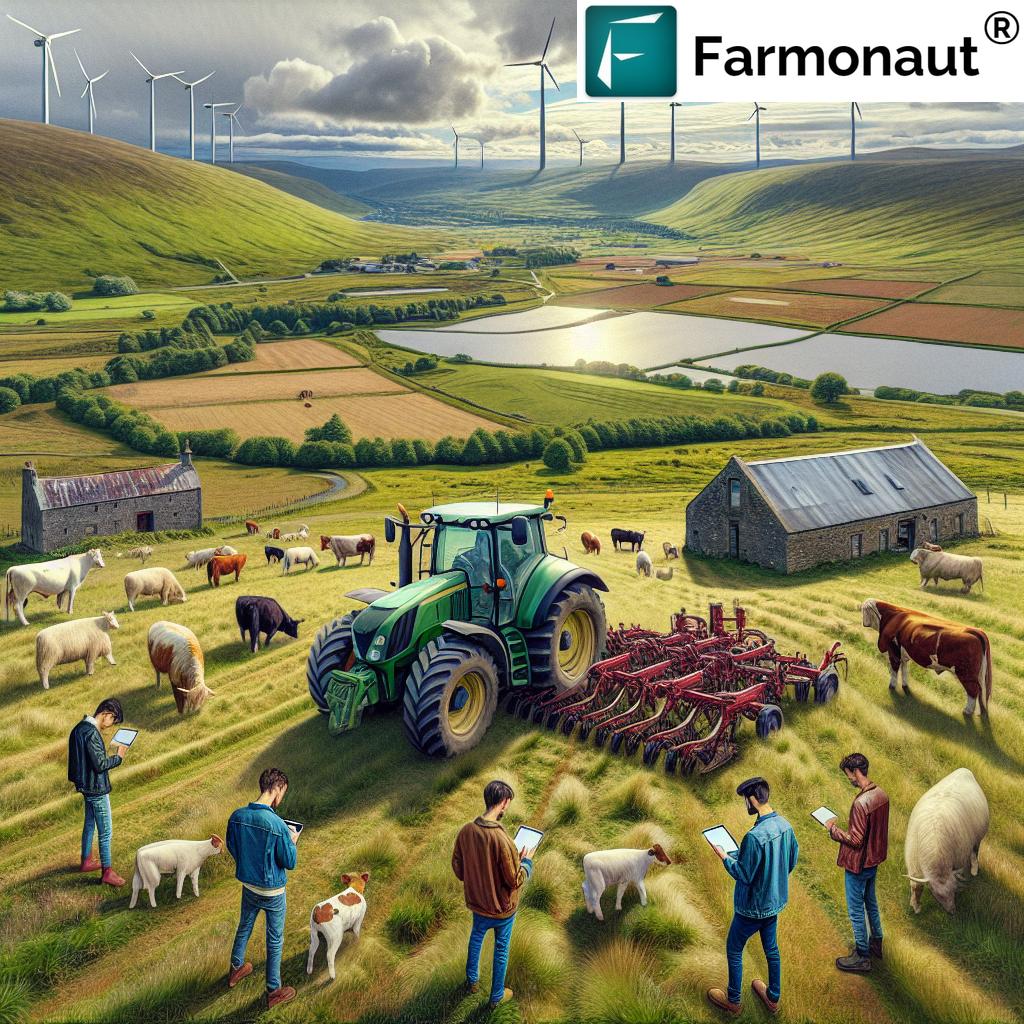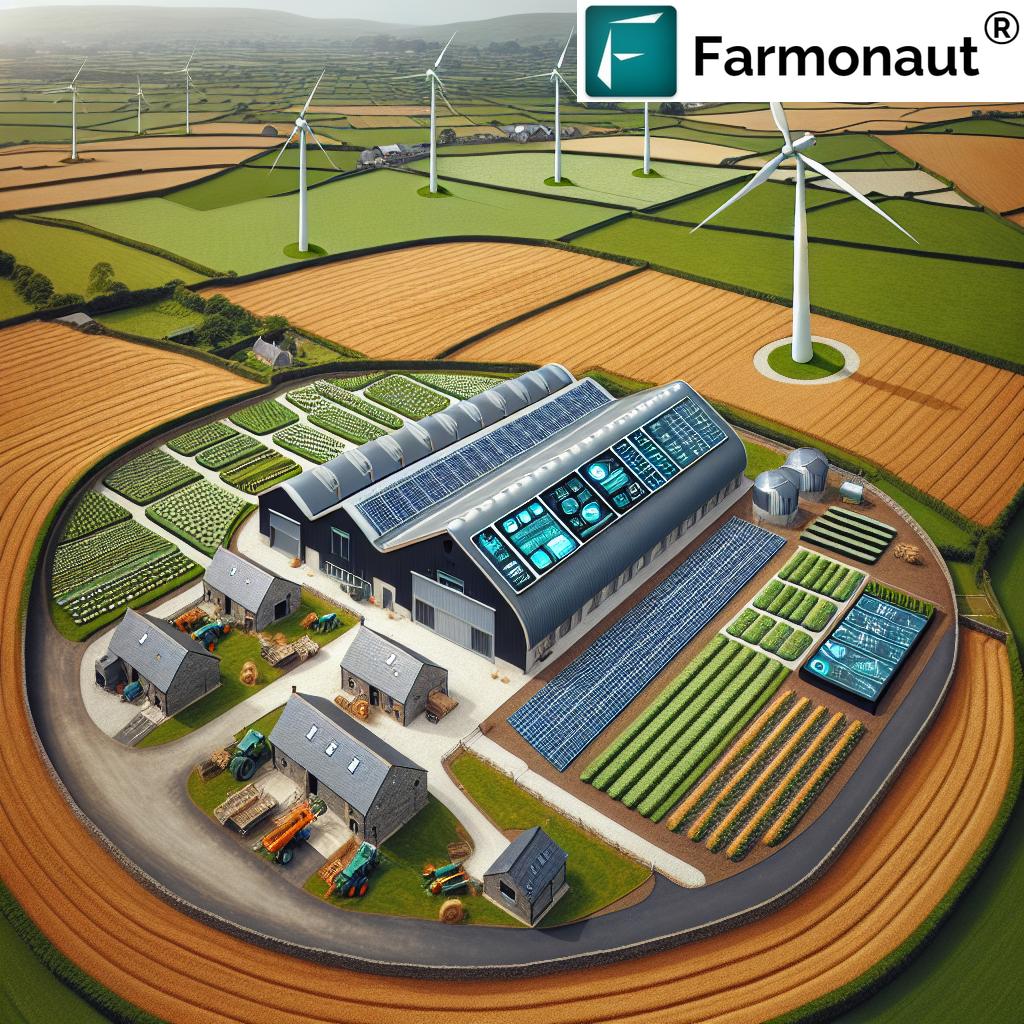UK’s Renewable Energy Revolution: How Lifting the Onshore Wind Ban Impacts Rural Development and Sustainable Farming
“The UK’s recent lifting of the onshore wind ban could potentially impact up to 17.5 million hectares of agricultural land.”
In recent news, the UK government has made a groundbreaking decision to lift the long-standing ban on onshore wind projects, marking a significant shift in the country’s renewable energy policy. This move has far-reaching implications for rural development, sustainable agriculture, and the future of farm diversification. As experts in agricultural technology and satellite-based farm management, we at Farmonaut are keenly observing these developments and their potential impact on the farming community.
The Dawn of a New Era in UK’s Renewable Energy Landscape
The lifting of the onshore wind ban heralds a new chapter in the UK’s commitment to sustainable energy production. This policy change is set to revolutionize the way we approach renewable energy projects, particularly in rural areas. Let’s delve into the key aspects of this development and its implications for farmers and landowners.
- Increased opportunities for rural property diversification
- Potential for new income streams through solar and wind energy projects
- Challenges in planning and grid integration
- Impact on agricultural land use for renewable energy
As we navigate this new landscape, it’s crucial to understand how these changes will affect the agricultural sector and the broader rural economy.
[Image 1]
The Impact of Onshore Wind Development on Sustainable Agriculture
The reintroduction of onshore wind projects presents both opportunities and challenges for the UK’s agricultural sector. On one hand, it offers farmers and landowners a chance to diversify their income through renewable energy projects. On the other, it raises questions about land use and the balance between food production and energy generation.
At Farmonaut, we understand the importance of sustainable land management. Our satellite-based crop monitoring technology can help farmers make informed decisions about land use, ensuring that renewable energy projects complement rather than compete with agricultural activities.
Explore Farmonaut’s satellite-based farm management solutions
[Video 1: How Farmonaut’s Satellite Technology is Revolutionizing Land Use in Agriculture]
Rural Property Diversification: A New Frontier
The lifting of the onshore wind ban opens up exciting possibilities for rural property diversification. Farmers and landowners now have the opportunity to participate in the renewable energy sector, potentially creating new revenue streams and contributing to the UK’s green energy targets.
- Leasing land for wind turbines
- Developing small-scale wind farms
- Integrating wind energy into existing farm operations
These diversification options can provide a much-needed boost to rural economies, creating jobs and fostering sustainable development in agricultural communities.
Discover Farmonaut’s API for integrating satellite data into your agricultural projects
Challenges in Planning and Grid Integration
While the lifting of the ban presents numerous opportunities, it also brings challenges, particularly in areas of planning and grid integration. Local authorities will need to adapt their planning processes to accommodate the increased interest in onshore wind projects. Additionally, integrating these new energy sources into the national grid will require significant investment and coordination.
We at Farmonaut believe that technology will play a crucial role in addressing these challenges. Our advanced mapping and monitoring tools can assist in site selection and impact assessment for wind farm projects, helping to streamline the planning process.
[Image 2]
The Role of Solar Energy in Farm Diversification
While the focus has been on onshore wind, it’s important to note that solar energy continues to play a significant role in farm diversification. Many farmers are already leveraging solar panels on farm buildings or developing solar farms on less productive land.
The combination of wind and solar projects on farms can create a robust and diversified renewable energy portfolio, providing stable income streams and contributing to the UK’s energy security.
Access Farmonaut’s API Developer Docs for integrating renewable energy data
[Video 2: Farmonaut’s Advanced Agri Solutions: Precision Crop Area Estimation – Egypt Case Study]
Policy Implications and Government Targets
The UK government‘s decision to lift the onshore wind ban aligns with its ambitious targets for reducing carbon emissions and increasing renewable energy production. This policy shift is expected to accelerate the country’s progress towards its climate goals and enhance energy security.
- Increased investment in renewable energy infrastructure
- Potential updates to planning laws and regulations
- New incentives for farmers and landowners to participate in renewable energy projects
As these policies evolve, we at Farmonaut remain committed to providing farmers with the tools and insights they need to navigate this changing landscape.
“Onshore wind farms in the UK can generate electricity for up to 4.5 million homes annually.”
Comparative Analysis: The Impact of Lifting the Onshore Wind Ban
| Impact Area | Pre-Ban Scenario | Post-Ban Scenario | Estimated Change |
|---|---|---|---|
| Farm Income Diversification (£/year) | Limited | Significant increase | +30-50% |
| Renewable Energy Output (GWh/year) | 10,000 | 25,000 | +150% |
| Agricultural Land Use for Wind Farms (hectares) | 5,000 | 15,000 | +200% |
| Rural Employment in Renewable Sector (jobs) | 5,000 | 12,000 | +140% |
| CO2 Emissions Reduction (tonnes/year) | 500,000 | 1,250,000 | +150% |
| Grid Integration Challenges (scale 1-10) | 3 | 7 | +133% |
| Planning Permission Success Rate (%) | 30% | 60% | +100% |
This table clearly illustrates the significant changes expected across various aspects of rural development and renewable energy production following the lifting of the onshore wind ban. The potential for increased farm income diversification and renewable energy output is particularly noteworthy.
Environmental Impact and Sustainable Farming Practices
The expansion of onshore wind projects is expected to have a positive impact on the environment, contributing to the reduction of greenhouse gas emissions. However, it’s crucial to balance this with sustainable farming practices to ensure food security and biodiversity conservation.
At Farmonaut, we’re dedicated to promoting sustainable agriculture through our advanced satellite monitoring and AI-driven advisory systems. Our technology can help farmers optimize their land use, ensuring that renewable energy projects coexist harmoniously with productive agricultural activities.
[Video 3: Unlocking Soil Organic Carbon: The Secret to Sustainable Farming with Farmonaut]
The Future of Rural Development and Renewable Energy
As we look to the future, the integration of renewable energy projects into rural landscapes presents exciting opportunities for sustainable development. The lifting of the onshore wind ban is just the beginning of a broader transformation in how we approach energy production and land use in rural areas.
- Emergence of “agrivoltaics” – combining solar energy production with crop cultivation
- Development of energy storage solutions to address intermittency issues
- Increased collaboration between farmers, energy companies, and technology providers
Farmonaut is at the forefront of this transformation, providing cutting-edge tools and insights to help farmers navigate this evolving landscape.
[Video 4: Farmonaut | Making Farming Better With Satellite Data]
Workforce Reallocation and Skills Development
The growth of the renewable energy sector in rural areas will necessitate workforce reallocation and skills development. Farmers and rural workers will need to acquire new competencies to take advantage of the opportunities presented by onshore wind and solar projects.
This shift may lead to the development of specialized courses and training programs focused on renewable energy management and sustainable farming practices. At Farmonaut, we’re committed to supporting this transition by providing educational resources and tools that empower farmers to embrace these new technologies.
Financial Considerations and Investment Opportunities
The lifting of the onshore wind ban is expected to attract significant investment to rural areas. Farmers and landowners considering renewable energy projects will need to carefully evaluate the financial implications, including:
- Initial investment costs
- Long-term revenue projections
- Potential impact on agricultural subsidies
- Tax implications and incentives
Financial institutions are likely to develop specialized products to support these investments, potentially including green loans and renewable energy-focused financial instruments.
The Role of Technology in Integrating Renewable Energy and Agriculture
As the renewable energy sector expands into rural areas, technology will play a crucial role in ensuring the efficient integration of energy production with agricultural activities. At Farmonaut, we’re continually developing innovative solutions to support this integration:
- Satellite-based land use optimization
- AI-driven crop health monitoring
- Precision agriculture techniques for maximizing land productivity
These technologies can help farmers make informed decisions about where to locate renewable energy projects while minimizing the impact on agricultural productivity.
Legal and Regulatory Considerations
The lifting of the onshore wind ban will likely be accompanied by updates to existing laws and regulations. Farmers and landowners interested in developing wind energy projects should be aware of:
- Changes to planning permission processes
- Environmental impact assessment requirements
- Grid connection regulations
- Land use restrictions and zoning laws
Staying informed about these legal and regulatory changes will be crucial for anyone looking to invest in onshore wind projects.
Community Engagement and Social Impact
The development of onshore wind projects in rural areas will require significant community engagement. Successful projects will need to demonstrate clear benefits to local communities, such as:
- Job creation and skills development
- Community ownership schemes
- Reduced energy costs for local residents
- Investment in local infrastructure and services
Engaging with local communities early and transparently will be crucial for gaining support for renewable energy projects and ensuring their long-term success.
The Global Context: Lessons from International Experiences
As the UK embarks on this new chapter in renewable energy development, there are valuable lessons to be learned from international experiences. Countries like Germany, Denmark, and Spain have long histories of integrating onshore wind into their rural landscapes.
Some key insights include:
- The importance of community ownership models
- Balancing energy production with landscape preservation
- Developing flexible grid systems to accommodate variable renewable energy sources
By studying these international examples, the UK can develop best practices for the sustainable integration of onshore wind into its rural areas.
Farmonaut’s Role in the Renewable Energy Revolution
At Farmonaut, we’re excited about the opportunities that the lifting of the onshore wind ban presents for sustainable agriculture and rural development. Our advanced satellite-based farm management solutions are perfectly positioned to support farmers and landowners as they navigate this new landscape.
Our technology can help:
- Identify optimal locations for wind turbines while minimizing impact on crop production
- Monitor the effects of renewable energy projects on surrounding agricultural land
- Provide data-driven insights for balancing energy production and farming activities
We’re committed to supporting the UK’s renewable energy revolution while ensuring the continued productivity and sustainability of its agricultural sector.
Conclusion: A Sustainable Future for UK Agriculture and Energy Production
The lifting of the onshore wind ban marks a significant milestone in the UK’s journey towards a more sustainable and resilient future. This policy change presents both opportunities and challenges for the agricultural sector, but with careful planning and the right technological support, it has the potential to transform rural economies and contribute significantly to the UK’s renewable energy targets.
As we move forward, the integration of renewable energy projects with sustainable farming practices will be crucial. At Farmonaut, we’re committed to providing the tools and insights needed to navigate this new landscape, ensuring that the UK’s rural areas can thrive in an era of clean energy and sustainable agriculture.
The future of UK farming is bright, powered by the wind and guided by the latest in agricultural technology. Together, we can build a more sustainable and prosperous rural economy for generations to come.
FAQ Section
Q1: How will the lifting of the onshore wind ban affect farmers?
A1: Farmers will have new opportunities for income diversification through leasing land for wind turbines or developing their own small-scale wind projects. However, they’ll need to carefully consider land use implications and potential impacts on their agricultural operations.
Q2: What are the main challenges in integrating onshore wind projects into rural areas?
A2: Key challenges include planning permissions, grid integration, balancing energy production with agricultural needs, and ensuring community support. Technological solutions and careful planning will be crucial in addressing these issues.
Q3: How can technology help in the development of sustainable onshore wind projects?
A3: Technologies like Farmonaut’s satellite-based farm management solutions can help optimize land use, monitor environmental impacts, and ensure that wind energy projects complement rather than compete with agricultural activities.
Q4: What financial considerations should farmers keep in mind when exploring wind energy projects?
A4: Farmers should consider initial investment costs, long-term revenue projections, potential impacts on agricultural subsidies, and tax implications. It’s advisable to seek professional financial advice and explore specialized green finance options.
Q5: How will the expansion of onshore wind affect rural employment?
A5: The growth of the renewable energy sector in rural areas is expected to create new job opportunities, both in construction and maintenance of wind farms and in related services. However, this may require reskilling and workforce reallocation in some areas.
















